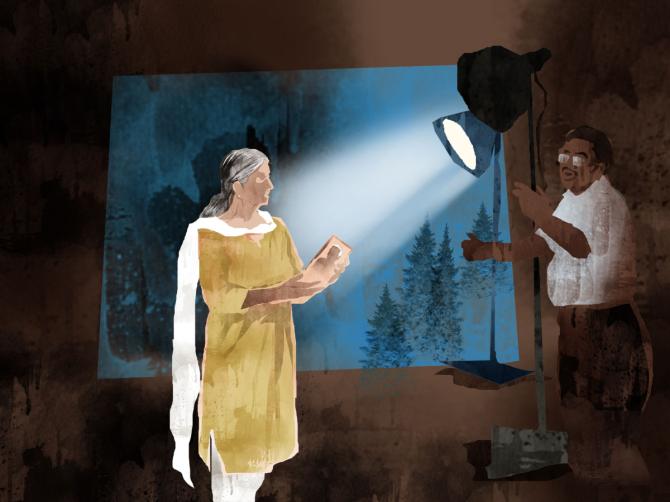Last pictures have that power to transcend time.
And last pictures can, sometimes, capture a lifetime, explains Veenu Sandhu.

Having run out of passport-size photographs and in urgent need of them, I headed to a photo studio in a market where, I was once told, 'You can find anything and everything -- from a nail to a diamond.' This magical market is located in south-east Delhi and is called Bhogal.
I don't recall the face of the helpful man who'd said this to me while pointing out directions to a sewing thread shop I was looking for back then. But his 'anything and everything' promise invariably comes to mind every time I am in this market that has it all.
And it's not just things it has all of. It also has those intangibles that are to be valued.
Branching out from its central road, for instance, are arterial lanes around which people from different religions were settled in the early years of Independence and which are named accordingly.
So there's a Gurdwara Road, named so because it has a gurdwara. There's a Mandir Road, named for its temple. There's a Masjid Road, with its Shahi Masjid. And there is a Church Road, named after its St Michael and All Angels Church.
The area also has a Buddhist monastery, Ravidas and Valmiki temples, and also temples dedicated to Sheetla Mata and Shiva.
For several years now, it has also had a very visible Afghan population, so shops with signages in Dari, the Afghan dialect of Persian, are common.
Once there also used to be a flower market here: Saman Bazaar (saman means 'jasmine' and the origin of the word lies in Persian).
Today, only the name remains and the lane is lined with vegetable and fruit vendors.
I reached the photo studio, marvelling -- yet again -- at this market of mini worlds that coexist with no visible friction.
Inside, the only other visitor was an elderly woman in a pale green suit and white dupatta.
She was frail, less than five feet tall, but with hands that looked strong enough to twist open a stubborn cap from a jam jar without any trouble.
I waited my turn. But the woman lingered on as the man at the counter said to her, "I told you that's all I can do. I can at best give you a discount."
My gaze followed hers to a framed 12-by-16-inch photograph on the counter.
It was an elderly man's picture in a thin, brown wooden frame that was slightly chipped in places. Was she bargaining for a new frame?
Possibly not, because the next thing she asked was: "Can you not make my frame the same as this one?" The man at the counter got up, went deeper into the studio and returned with another framed photograph.
It was of the elderly woman in a reddish brown sari and a white blouse.
The frame was the colour of the sari and thicker than the elderly man's. "What's wrong with this picture?", the studio owner asked her.
"You're looking nice. And no one makes those kinds of frames anymore." But she just stood there looking at him.
Resigned, he shook his head and said, "You know, it's what you said to me when you came to get this picture taken. Okay, all right, I will take another one and I won't charge you for it."
Then he turned to me, possibly sensing the curiosity, and narrated the story.
The woman had told him this would be her last picture, one that her children could place at her prayer meet once she was gone.
When someone dies, she'd said, the family often scrambles to look for an appropriate picture for the prayer meet. And often, they just make do with whatever they are able to find. She didn't want that to happen, and she also wanted a picture that somehow captured the person she was.
The last picture. There is so much to be expected of it, but how can it even begin to capture a person's life? That's like putting a lifetime in one frame. But her incredibly sad, and determined, quest for such a picture did make me think of some other last pictures I had encountered while browsing the Internet one day.
These were from an exhibition hosted at the British Museum in the 1990s.
Titled Ancient Faces: Mummy Portraits from Roman Egypt, it featured startlingly realistic portraits of men and women painted right after their death and buried with their mummified bodies in sealed tombs.
There is a lovely blog post about it on the British Museum Web site that talks about this practice that flourished in Roman Egypt from the first to the third century AD.
From these last portraits, life-like faces look you in the eye, causing the centuries that separate them from us to fade away.
Last pictures have that power to transcend time. And last pictures can, sometimes, capture a lifetime.
Feature Presentation: Rajesh Alva/Rediff.com









